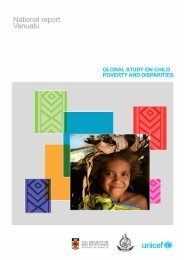A Strategic Assessment of the Children's Services Industry
A Strategic Assessment of the Children's Services Industry
A Strategic Assessment of the Children's Services Industry
- No tags were found...
Create successful ePaper yourself
Turn your PDF publications into a flip-book with our unique Google optimized e-Paper software.
STRATEGIC ASSESSMENT OF THE CHILDREN’S SERVICES INDUSTRYIn general, children from disadvantaged backgrounds do not attend child care at <strong>the</strong> same rateas <strong>the</strong>ir more privileged peers (SCRGSP, 2008: 3.14). Aboriginal and Torres Strait Islanderchildren are under represented in government funded child care places. They comprise 4.4per cent <strong>of</strong> <strong>the</strong> population <strong>of</strong> children aged 0-5, but just 1.8 per cent <strong>of</strong> children using childcare. Child care attendance is also lower among children who live in remote areas. Childrenwith disabilities are also underrepresented, making up 5.2 per cent <strong>of</strong> <strong>the</strong> population <strong>of</strong>children aged 0-5, but only 2.5 per cent <strong>of</strong> <strong>the</strong> children in approved child care. Children fromnon-English speaking backgrounds and children from low income families make up a greaterproportion <strong>of</strong> child care attendees than <strong>the</strong>y do in <strong>the</strong> population <strong>of</strong> children aged 0-5.Evidence is mixed regarding use <strong>of</strong> child care by children from low income families. TheABS Child care Survey indicates that among children living with couple parents, <strong>the</strong>proportion <strong>of</strong> low income children using long day care is lower than that <strong>of</strong> higher incomefamilies (Table 2.3). Among lone parent families, <strong>the</strong> unreliability <strong>of</strong> data for high incomefamilies means that it is difficult to determine patterns <strong>of</strong> long day care use by income.The pattern <strong>of</strong> lower rates <strong>of</strong> use by children from lower income families holds when all 0-12year-old children’s use <strong>of</strong> formal care is examined using <strong>the</strong> Child care Survey (ABS, 2006:26-27).Table 2.3: Proportion <strong>of</strong> children using long day care by weekly income <strong>of</strong> parents, 2005CouplefamiliesLone parentfamiliesLess than $400 8.3 8.2$400-$599 5.1*$600-$799 8.5} 10.3$800-$999 9.7$1000-$1199 11.5} 15.5*$1200-$1399 9.2$1400-$1999 11.4} 5.6*$2000 or more 11.1Total 9.6 9.4Source: ABS, 2006: 26-27.*estimate has a relative standard error <strong>of</strong> 25% to 50% and should be used with caution.** estimate has a relative standard error greater than 50% and is considered too unreliable for general use.In contrast, <strong>the</strong> Australian Government Census <strong>of</strong> Child care <strong>Services</strong> shows that childrenfrom low income families are well represented in <strong>the</strong>ir child care use. As reported by <strong>the</strong>Productivity Commission, <strong>the</strong> participation in child care <strong>of</strong> children aged 0-12 years fromfamilies with an income <strong>of</strong> $33,361 (<strong>the</strong> cut-<strong>of</strong>f point for receiving <strong>the</strong> maximum amount <strong>of</strong>Child care Benefit as at May 2006) is equal to <strong>the</strong>ir representation in <strong>the</strong> community(SCRGSP, 2008: 3A.20).It is not clear why <strong>the</strong>se two surveys tell a different story with regard to children from lowincome households. Perhaps it is due to different survey methods, <strong>the</strong> fact that one surveysparents, <strong>the</strong> o<strong>the</strong>r child care providers might affect <strong>the</strong> findings. Or perhaps incomedifferences are hidden by Census data being presented for all child care services, ra<strong>the</strong>r thanbroken down into different forms <strong>of</strong> care. However, given <strong>the</strong> numbers <strong>of</strong> parents citing costas an impediment to using child care and <strong>the</strong> particular importance <strong>of</strong> early years educationand care services for <strong>the</strong> development <strong>of</strong> children from disadvantaged backgrounds, thisdisparity warrants fur<strong>the</strong>r and more detailed investigation.10
















